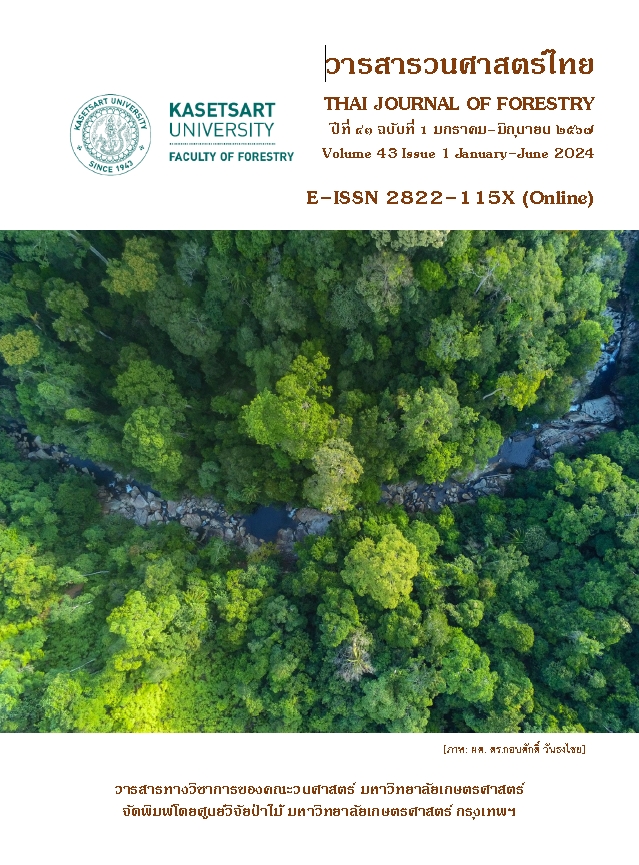อิทธิพลของอุณหภูมิในการอัดร้อนต่อสมบัติของแผ่นชิ้นไม้อัดจากขี้เลื่อยไม้สักในจังหวัดแพร่
Main Article Content
บทคัดย่อ
การศึกษาอิทธิพลของอุณหภูมิในการอัดร้อนแผ่นชิ้นไม้อัดจากขี้เลื่อยไม้สักในจังหวัดแพร่ มีวัตถุประสงค์เพื่อศึกษาผลกระทบของอุณหภูมิในการอัดร้อนต่อสมบัติของแผ่นชิ้นไม้อัด โดยทำการอัดร้อนที่อุณหภูมิ 80, 100 และ 120 องศาเซลเซียส และทำการทดสอบค่าสมบัติทางกายภาพและกลศาสตร์ ได้แก่ ความชื้น (moisture content) ค่าความหนาแน่น (density) ค่าการดูดซึมน้ำ (water absorption) ค่าการพองตัวตามความหนา (thickness swelling) ค่าแรงดึงตั้งฉากกับผิวหน้า (internal bonding) ค่ามอดูลัสแตกหัก (modulus of rupture) และค่ามอดูลัสยืดหยุ่น (modulus of elasticity) ซึ่งผลการทดลองพบว่า แผ่นชิ้นไม้อัดจากขี้เลื่อยไม้สักที่อุณหภูมิในการอัด 120 องศาเซลเซียส มีค่าการทดสอบดีที่สุดในทุกสภาวะ และผ่านมาตรฐานการทดสอบทั้งหมดโดยมีค่าความชื้นเฉลี่ยร้อยละ 6.65±2.03 ค่าความหนาแน่นเฉลี่ย 688.90±10.27 กิโลกรัมต่อลูกบาศก์เมตร ค่าการดูดซึมน้ำเฉลี่ยร้อยละ 37.73±20.67 ค่าการพองตัวตามความหนาเฉลี่ยร้อยละ 10.89±5.49 ค่าแรงดึงตั้งฉากกับผิวหน้าเฉลี่ย 0.43±0.02 เมกะปาสกาล ค่ามอดูลัสแตกหักเฉลี่ย 15.73±0.88 เมกะปาสกาล และค่ามอดูลัสยืดหยุ่นเฉลี่ย 2,384±11.95 เมกะปาสกาล
Downloads
Article Details

อนุญาตภายใต้เงื่อนไข Creative Commons Attribution-NonCommercial-NoDerivatives 4.0 International License.
ข้าพเจ้าและผู้เขียนร่วม (ถ้ามี) ขอรับรองว่า ต้นฉบับที่เสนอมานี้ยังไม่เคยได้รับการตีพิมพ์และไม่ได้อยู่ในระหว่างกระบวนการพิจารณาตีพิมพ์ลงในวารสารหรือสิ่งตีพิมพ์อื่นใด ข้าพเจ้าและผู้เขียนร่วม (ถ้ามี) ยอมรับหลักเกณฑ์และเงื่อนไขการพิจารณาต้นฉบับ ทั้งยินยอมให้กองบรรณาธิการมีสิทธิ์พิจารณาและตรวจแก้ต้นฉบับได้ตามที่เห็นสมควร พร้อมนี้ขอมอบลิขสิทธิ์ผลงานที่ได้รับการตีพิมพ์ให้แก่วารสารวนศาสตร์ คณะวนศาสตร์ มหาวิทยาลัยเกษตรศาสตร์ กรณีมีการฟ้องร้องเรื่องการละเมิดลิขสิทธิ์เกี่ยวกับภาพ กราฟ ข้อความส่วนใดส่วนหนึ่ง หรือ ข้อคิดเห็นที่ปรากฏในผลงาน ให้เป็นความรับผิดชอบของข้าพเจ้าและผู้เขียนร่วม (ถ้ามี) แต่เพียงฝ่ายเดียว และหากข้าพเจ้าและผู้เขียนร่วม (ถ้ามี) ประสงค์ถอนบทความในระหว่างกระบวนการพิจารณาของทางวารสาร ข้าพเจ้าและผู้เขียนร่วม (ถ้ามี) ยินดีรับผิดชอบค่าใช้จ่ายทั้งหมดที่เกิดขึ้นในกระบวนการพิจารณาบทความนั้น”
เอกสารอ้างอิง
Howpinjai, I., Sukjaroen, S., Wanishdilokratn, T. 2019. The comparison of wood utilization: Case study of Phrae province. Thai Forest Ecological Research Journal, 3(2): 17-25. (in Thai)
Iswanto, A.H., Febrianto, F., Hadi, Y.S., Ruhendi, S., Hermawan, D. 2013. The effect of pressing temperature and time on the quality of particleboard made from jatropha fruit hulls treated in acidic condition. Makara Seri Teknologi, 17(3): 145-151. doi: 10.7454/mst.v17i3.2
Kamyo, T., Suwannawon, S. 2017. Land cover changes in the Rong Kwang district, Phrae province based on a systematic remote sensing sampling approach. Thai Forest Ecological Research Journal, 1(1): 10-18. (in Thai)
Korai, H. 2021. Difficulty of internal bond prediction of particleboard using the density profile. Journal of Wood Science, 67(1): 1-7. doi: 10.1186/s10086-021-01994-4
Kornitsaranukoon, W., Toyjalearn, N., Sorathorn, S. 2019. Development particleboard for interior wall panel building from hemp woody core. Journal of Building Energy & Environment, 3(3): 78-96. (in Thai)
Kusumah, S.S., Massijaya, S.Y., Prasetyo, K.W., Sutiawan, J., Lubis, M.A.R., Hermawan, D. 2020. Surface modification of eco-friendly particleboard made from sorghum bagasse and citric acid sucrose adhesive. Materials Science and Engineering, (2020): 012054. doi: 10.1088/1757-899X/935/1/012054
Masturi, Jannah, W.N., Maulana, R.M., Darsono, T., Sunarno, Rustad, S. 2020. Mechanical and physical properties of teak leaves waste/polyurethane composites for particleboard application. Advanced Composites Letters, 29(19): 2633366X2096250. doi: 10.1177/2633366X20962507
Muenmee, S., Bootdee, S. 2021. Health risk assessment of exposure PM2.5 from industrial area in Pluak Daeng district, Rayong province. Naresuan Phayao Journal, 14(3): 95-110. (in Thai)
Nourbakhsh, A. 2010. Mechanical and thickness swelling of particleboard composites made from three-year-old poplar clones. Journal of Reinforced Plastics and Composites, 29(4): 481-489. doi: 10.1177/0731684408097771
Prungsuk, S., Jarusombuti, S., Veenin, T. 2019. Effect of added boron compounds on physical, mechanical and fire retardant properties in particleboard. Thai Journal of Forestry, 38(1): 156-167. (in Thai)
Soviwadan, D., Kassegne, K.A., Kadja, K., Koffi, D., Koutsawa, Y., Sanda, K. 2019. Evaluation of mechanical, physical and thermal properties of particleboard from teak (Tectona grandis) sawdust with the tannic powder of African locust bean pod (Parkia biglobossa). International Journal of Current Research, 11(6): 4821-4829. doi: 10.24941/ijcr.35744.06.2019
Thai Industrial Standard. 2004. Thai Industrial Standard for Flat pressed Particleboard. TIS876- 2004.
Wanishdilokratn, T., Sukjareon, S., Howpinjai, I., Kamyo, T., Wiangtong, C. 2022. Comparison of timber volumes during teak bed production between Wiang Thong and Mee Kong factories in Sung Men district, Phrae province. Thai Journal of Forestry, 41(2): 116-126. (in Thai)
Yenjai, P., Jarusombuti, S., Veenin, T. 2016. Particleboard manufacturing from waste of Cajuput (Melaleuca cajuputi Powell). VRU Research and Development Journal Science and Technology, 11(2): 131-140. (in Thai)
Yiachongthor, C. 2021. The Added Value of Teak Sawdust from Sawmill in Xiengnguern District Luangprabang Province to Particleboard for Furniture Production. M.S. Thesis, Maejo University, Chiang Mai, Thailand. (in Thai)


